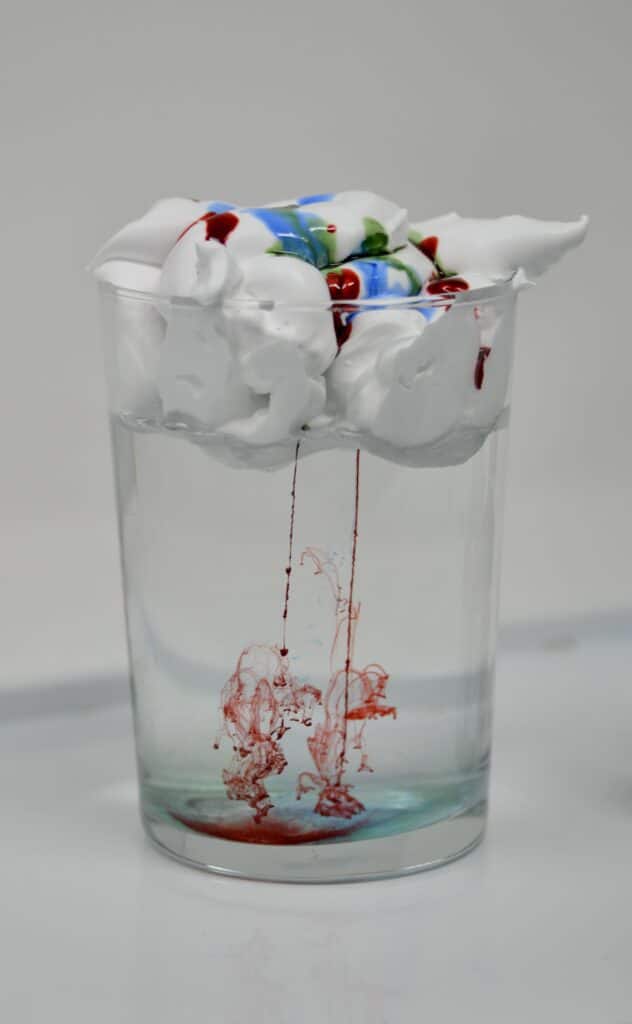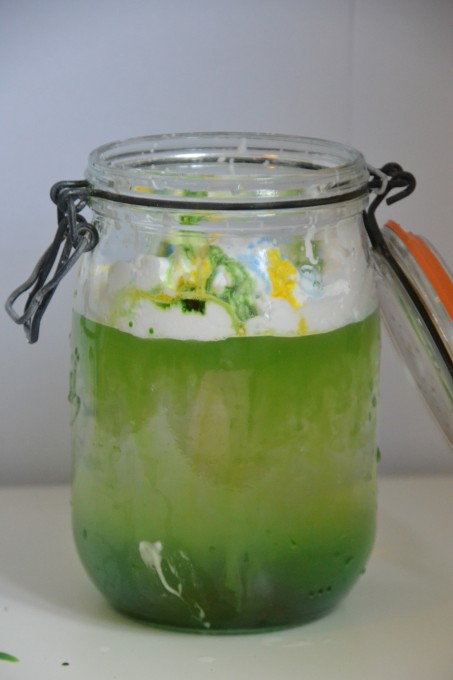- Skip to primary navigation
- Skip to main content
- Skip to primary sidebar

- FREE Experiments
- Kitchen Science
- Climate Change
- Egg Experiments
- Fairy Tale Science
- Edible Science
- Human Health
- Inspirational Women
- Forces and Motion
- Science Fair Projects
- STEM Challenges
- Science Sparks Books
- Contact Science Sparks
- Science Resources for Home and School

Rain Cloud in a Jar
May 26, 2015 By Emma Vanstone 4 Comments
This simple visual activity is great for understanding why rain falls and how clouds form.
Children can experiment with different sizes and shapes of shaving foam clouds and watch how it affects how the food colouring rain falls.

What is a cloud?
Clouds are droplets of water and crystals of ice. The exact composition depends on the temperature. Clouds form when warm air rises, expands and cools. Water molecules then attach to dust, pollution and smoke particles. When these molecules come together, they form a cloud. Clouds float because the water droplets forming them are warmed up by the heat from the sun, and warm air rises.
The altitude at which clouds form depends on several factors, such as air temperature, wind and size of the cloud.
How to make a rain cloud in a jar
You’ll need
Shaving Cream
Food colouring
Dropper or pipette
Rain cloud in a jar instructions
Fill the jar about ¾ full with water
Cover with shaving cream to completely cover the surface of the water. The shaving foam represents a cloud.
Drip water over the shaving foam using a pipette
Drop food colouring over the shaving foam.
Watch the food colouring fall to the bottom of the jar.
How does a rain cloud in a jar work?
Clouds form when water vapour rises and cools back into water droplets to form clouds.
When a rain cloud reaches a certain mass, the water needs to escape and so breaks through the cloud to fall as rain. As you drip the water over the shaving cream cloud, the water starts to fall through the cloud.
Our rain cloud in a jar is a very simple model of how rain forms, but it is a lot of fun to set up and watch!

Why are rain clouds grey?
When clouds become full of water droplets, they are so thick that light cannot travel through them, making the cloud look grey! This is why grey clouds are a sign that rain is about to fall.

More rain and water science experiments
Make a model of the water cycle to learn how water is recycled over and over again!
Did you know most rain comes from the sea ?
Find out why raindrops form sphere shapes .
Try a very simple evaporation investigation .
Inspiration Laboratories has a great cloud in a bottle activity .

Last Updated on February 7, 2023 by Emma Vanstone
Safety Notice
Science Sparks ( Wild Sparks Enterprises Ltd ) are not liable for the actions of activity of any person who uses the information in this resource or in any of the suggested further resources. Science Sparks assume no liability with regard to injuries or damage to property that may occur as a result of using the information and carrying out the practical activities contained in this resource or in any of the suggested further resources.
These activities are designed to be carried out by children working with a parent, guardian or other appropriate adult. The adult involved is fully responsible for ensuring that the activities are carried out safely.
Reader Interactions
September 18, 2017 at 8:43 am
its a great app to the students of my age …… i’m so happy to use it and to now more about the science …..
Leave a Reply Cancel reply
Your email address will not be published. Required fields are marked *
- Skip to primary navigation
- Skip to main content
- Skip to primary sidebar
- Skip to footer
DO YOU WANT TO RAISE EXTRAORDINARY KIDS?

How kids think, learn and thrive
How to Make a Rain Cloud in a Jar (+ Printables)
October 7, 2024 By Eva Leave a Comment
Inside: Experience the thrill and education of replicating weather phenomena! Create a rain cloud in a jar and dive into some scientific fun. This experiment is perfect for both children and adults to enjoy.
Imagine being able to create your very own miniature rain cloud in a jar right in the comfort of your own home.
Sounds like magic, right?
Well, believe it or not, it’s actually a fun and educational science experiment that both kids and adults can enjoy. Not only does it provide a hands-on learning experience, but it also introduces important concepts such as the water cycle and evaporation . Our Rain Cloud in a Jar science pages, which perfectly complement the activity, are available for free download below. Scroll down to the red button to enter your email, and I will send you the PDF.

In this article, we will dive into the step-by-step process of creating a rain cloud in a jar and explore the science behind it. Get ready to unleash your inner scientist and create some clouds with us!
Rain Cloud in a Jar Science Experiment
Here’s how you can conduct this experiment:

What you need:
A clear drinking glass (or two)
Shaving cream
Blue food coloring
What to do:
Step 1: pour water into the glass.

Begin by filling the jar about 3/4 full with water. This will serve as the “air” in our experiment.
Step 2: Squirt a large dollop of shaving cream on top

Add a layer of shaving cream on top of the water. This will serve as the “cloud”. Ensure that the shaving cream forms a thick layer on top of the water, but remember not to overfill as it represents the limited amount of water that a cloud can hold.
Step 3: Mix some food coloring with water

In a separate container, mix some water with a few drops of blue food coloring. Stir the mixture so that the color is evenly distributed. This will represent the “rain”.
Step 4: Squirt “rain” on top of the “cloud”

Now, using a dropper, start adding drops of the colored water to the cloud. Explain to the children that these are like the water droplets that get lifted up into the atmosphere.
Step 5: Keep adding drops to the cloud until it starts to “rain”

Keep adding drops to the cloud until it starts to “rain.” As the shaving cream gets saturated with water, it will eventually let the water flow through and drip down into the jar, like rainfall.
Step 6: Watch and discuss what is happening

Watch and discuss what is happening. Basically, the cloud (shaving cream) fills up with water until it becomes too heavy, and then it starts to rain (the blue water seeps through the shaving cream and into the water below).
My kids used different shades of blue to make their cloud jars. The next thing to do is to make a rainbow cloud!
Through this experiment, learners can better understand the concept of saturation and how clouds form and produce rain. It’s a simple yet effective demonstration of the water cycle, which is an important part of Earth’s weather system. Let’s look more closely at how rain is formed.

The science behind the experiment
Rain doesn’t just appear out of the blue sky. Clouds play an essential role in Earth’s water cycle.
Clouds are formed from water or ice that has evaporated from the Earth’s surface. Acting as reservoirs, they collect water droplets.
As these droplets increase in size, they eventually become too heavy to remain suspended in the cloud. Consequently, they fall to Earth, a phenomenon known as precipitation or rain.

Isn’t it amazing to learn about these everyday marvels?

For more weather science experiments, check out our collection.
Related Posts:
- How to Make DIY Snow to Beat Winter Boredom
- Fascinating Weather Science: 40 ways to play and learn
- The Science of Puddles (hands-on experience!)
- 100 Great Children’s Books (Beyond the Classics)
- Amazing Edible Science: Homemade Butter in a Jar
Reader Interactions
Leave a reply cancel reply.
Your email address will not be published. Required fields are marked *
Follow us on Pinterest

Let’s Connect
Search this site.

IMAGES
VIDEO